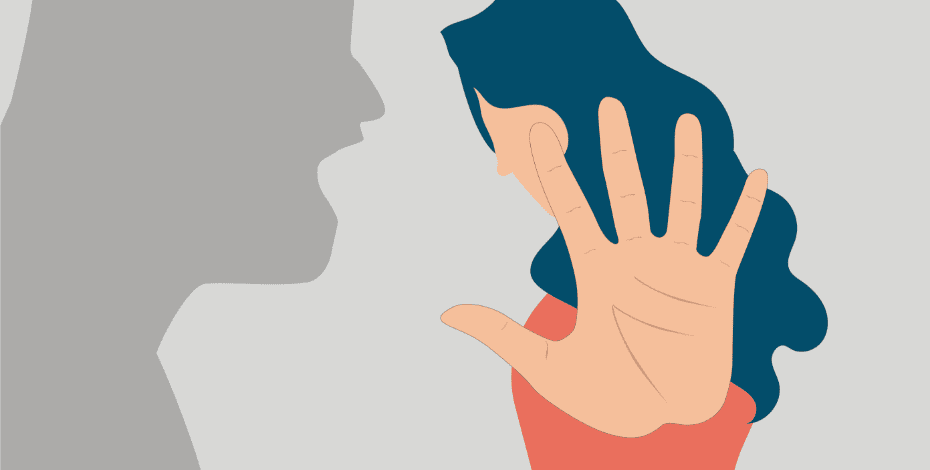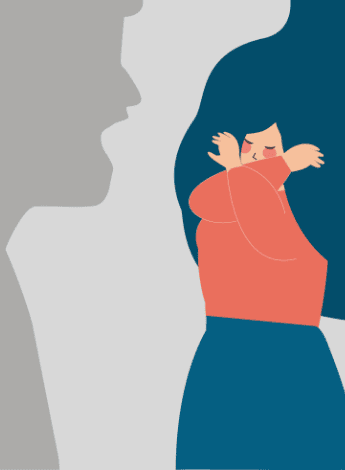
Family violence is everyone's problem

Family, domestic and intimate partner violence affects up to one in four women in Australia. Physiotherapists have a role to play in combating family violence and need to understand why it’s important.
Right now in Australia, one in four women and one in 14 men will experience physical and/ or sexual violence from an intimate partner from the age of 15.
Similarly, one in five women and one in seven men will experience emotional abuse by a current or previous partner.
Economic abuse affects one in six women and one in 12 men (Australian Institute of Health and Welfare 2025).
These numbers are likely to be under-reported.
Family, domestic and intimate partner violence (family violence) occurs in all cultures and communities in Australia, affecting people from varied backgrounds, ages, religions, genders, sexual orientations, education levels, income levels and social positions.
It encompasses physical, emotional and sexual violence as well as forms of coercive control including economic/financial abuse (see below).
Nicole (a pseudonym) is a physiotherapist working in women’s health in Western Australia who is passionate about raising awareness among physiotherapists of family violence.
Physiotherapists and other healthcare practitioners are often the first point of contact for people who have experienced or are experiencing family violence.
They should recognise the signs of family violence and understand what actions they can and should take to support these patients.
‘I’ve worked in public hospitals, private practice and the armed forces—and for the past 15 years in women’s health—and in each of these roles I have been a recipient of disclosures about family and domestic violence.
‘I wish I had been taught how to respond in a trauma-informed manner,’ Nicole says.
In November 2024, Ahpra, the Office of the Health Ombudsman, the Health Professional Councils Authority and the Health Care Complaints Commission released a joint position statement on family violence (Ahpra 2024), reminding practitioners of the critical contribution they can make.
‘Family violence damages the physical and psychological health, wellbeing and future life opportunities of victim-survivors and impacts families and communities.
‘The psychological consequences of family violence can be as serious and as enduring as the physical effects,’ the joint statement says.
The statement makes it clear that health practitioners play an important role in supporting efforts to end family violence.
It also sets clear expectations for practitioners and regulators in identifying family violence and responding sensitively, safely and respectfully to prevent further harm.
Practitioners are legally required to report other health practitioners who perpetrate family violence to the appropriate regulatory authorities, such as the Physiotherapy Board of Australia, which may lead to conditions on or suspension, cancellation or refusal of their registration.
The joint statement follows the Australian Government’s National Plan to End Violence against Women and Children 2022–2032, which was released in 2022 and aims to end gender-based violence in one generation.
Family violence has multiple impacts on health
Family violence can affect health in a variety of ways beyond the obvious injuries that may result from physical violence.
Injuries are often hidden by the perpetrator, who may deliberately aim for places on the body that will be hidden by clothing.
Many injuries, including concussions, bruises and fractures, go unreported or excuses are made for how the injury occurred—clumsiness, a fall, an accident.
It’s not always acute injuries, says Nicole.
Chronic pain and chronic conditions can result from family violence, especially intimate partner violence.
Physiotherapists who are familiar with treating pain understand that there is an important biopsychosocial component to persistent pain.
‘Many conditions have been linked to the impact of intimate partner violence—headaches, eating disorders, chronic pain, anxiety, depression,’ she says.
‘Endometriosis and pelvic pain have also been linked to intimate partner violence.
‘The body keeps score.’
An example of this is a patient whose pain doesn’t fit the clinical picture suggested by their other symptoms.
Nicole says this is a red flag for her that something else may be going on.
‘When things don’t fit into my assessment jigsaw puzzle, I look elsewhere,’ she says.
‘I saw a patient recently who walked too well for the level of pain she was describing.
‘I asked her how things were at home and it became clear that what was happening to her— her ex-partner was stalking her and causing problems with her children and her new partner—was affecting her body.’
Another patient who came in unable to uncurl their fingers was eventually diagnosed with clenched fist syndrome, a psychosomatic disorder.
‘When I first saw them, their hand hadn’t been opened for months.
‘We straightened their hand out, we strengthened it, and they were discharged.
‘Sometime later they reappeared with the same thing.
‘Again, I treated them; they got better; we discharged them.
‘It wasn’t until a later attendance they came in that I asked the patient whether anything had happened to them.
‘They didn’t answer me but when I returned to my desk after lunch, there was a letter disclosing that they had been raped.
‘They hadn’t told anybody,’ Nicole says.
Nicole says that asking a patient the right questions can provide clues that they might be experiencing family violence.
‘I don’t ask them direct questions at first.
‘You can have a lovely conversation along the lines of “What do you like to do in your spare time? What do you do on the weekend? Do you catch up with your friends? Are you working? Do you have your own money?”
‘It helps people feel comfortable.
‘They might not disclose the first time you ask them questions because they’re trying to determine if you’re someone they can trust.
‘Then they might disclose at a different time,’ she says.
Other red flags might include a partner who always accompanies the patient to appointments or even answers questions for them; the patient’s demeanour, which could be defensive or submissive; or a patient who frequently misses appointments with excuses like not having money for bus fare or that their partner took the car that day, preventing them from getting there and hinting at coercive control.
‘If people are anxious and always looking at their phone or they’re worried about their partner having to come there to pick them up and they say “Look, I feel alright” or “He likes to know where I am”, all of those things are red flags to me,’ Nicole says.
Sensitivity, respect and safety
When a patient trusts you enough to disclose family violence, the most important thing is to acknowledge and validate their concerns.
‘I now have pre-planned words to say because when the disclosure occurs, it’s sometimes really difficult.
‘My mind is racing, my stomach feels sick and I know how important my words are.
‘I say, “I am so sorry that has happened to you. What can I do to help you?”
‘These words have worked in a lot of different situations,’ Nicole says.
The next step is to ask the patient if they need assistance in contacting people who can help them, such as social workers and organisations that help women to escape family violence situations.
In a hospital environment, it might be as easy as walking the patient down the hall to see a social worker.
Nicole cites a patient who came in with complex regional pain syndrome in her arm and disclosed that she was worried that she was a victim of domestic violence.
The woman was hospitalised for surgery and during her stay, the hospital organised for her to see a social worker and start to make plans for escaping her situation.
In private practice it can be trickier.
You can make a call with them to 1800 RESPECT (the national hotline for family violence) or ask if you can let their GP know.
Nicole says it might be necessary to leave a patient’s phone at reception while you take them out the back door to someone who can help them make plans to leave.
First and foremost, the patient’s safety needs to be considered.
‘Once a client booked a number of physiotherapy appointments with me, during which the client instead attended social work appointments.
‘The physio appointments were approved by her husband, but he would never have agreed for her to see a social worker.
‘She did this for three to four appointments and then I never saw her again and she was taken into a refuge.’
Sometimes a patient is not ready to seek help—they may not feel safe about leaving yet, and there may be factors, like children, that prevent them from leaving at that point.
In that case, Nicole says, provide them with a phone number for a family violence service provider in a safe, secure, spot to access if they need to—for example, as a number next to the physio’s name in their phone.
Another approach is to make sure there are information sheets and flyers available in the waiting room.
These don’t have to be overtly about family violence.
A women’s health clinic might have information about respectful, healthy relationships, for example.
What if it’s a colleague?
Physiotherapy practices need to be aware of family violence as it pertains to their own employees too.
If a clinic employee is a victim-survivor of family violence, it may be necessary to support them by removing their name/photo from the website or making sure that reception staff are aware of restraining orders.
Many people don’t know that in Australia, all employees are entitled to 10 days of paid family and domestic violence leave each year, whether they are full-time, part-time or casual employees.
‘Managers need to know how to support staff through this process.
‘This can include things like removing their name from the reception board and making sure they didn’t walk to their car alone,’ Nicole adds.
Ahpra and the Physiotherapy Board of Australia also consider the impact of health practitioners who themselves are perpetrators of family violence.
As noted earlier, a health practitioner who perpetrates family violence should be reported to the appropriate health regulator.
Read Ahpra's Joint position on family violence by regulators of health practitioners.
What is family, domestic and intimate partner violence?

‘Family violence’, ‘domestic violence’ and ‘intimate partner violence’ are commonly used terms; however, each state and territory in Australia defines family violence differently.
Here we’ve chosen to use the term ‘family violence’ to align with the joint position statement from the health regulators (Ahpra, 2024).
We’ve also used the term ‘victim-survivor’ for people who have experienced family violence and ‘perpetrator’ to refer to the person who abuses the victim-survivor.
The National Plan to End Violence against Women and Children 2022–2032 notes that ‘family violence is a broader term than domestic violence, as it refers not only to violence between intimate partners but also to violence perpetrated by parents (and guardians) against children, between other family members and in family-like settings’ (Department of Social Services 2022).
In the Joint position on family violence by regulators of health practitioners released by Ahpra and other health regulatory agencies (Ahpra 2024), family violence is defined as ‘…violence between family members, as well as domestic violence between intimate partners, including a current or previous partner, regardless of whether they lived together’.
The statement notes that it can encompass carers, extended family and broader marital and kinship relationships as well as indirect effects on other family members including children.
The joint statement notes that family violence includes but is not limited to:
- coercive control, which is violent, threatening, isolating or other behaviour by a person to coerce or control a member of the person’s family or cause the family member to be fearful
- homicide
- physical violence and abuse
- sexual violence
- reproductive abuse
- emotional and psychological abuse
- harassment and stalking
- elder abuse
- financial/economic abuse
- technology-related violence
- social violence
- spiritual violence.
Where to get help
If you have a concern about a health practitioner, contact:
Ahpra 1300 419 495
Health Care Complaints Commission (New South Wales) (02) 9219 7444, 1800 043 159 (toll-free in New South Wales)
Health Professional Councils Authority (New South Wales) 1300 197 177
Office of the Health Ombudsman (Queensland) 133 646
Women’s health services
Men’s health services
1300 789 978
If you experience, see or hear family violence occurring, call:
Australian police services
Triple Zero (000)
Emergency or life-threatening situation
Police Assistance Line
131 444
Non-emergency but you require police assistance
Crime Stoppers
1800 333 000
To report information
Family violence information and services
1800 RESPECT
1800 737 732
Kids Helpline
1800 55 1800
Support for Aboriginal and Torres Strait Islander Peoples
13 YARN (13 92 76)
Rainbow Sexual, Domestic and Family Violence Helpline
1800 497 212
fullstop.org.au/get-help/our-services/rainbowviolenceandabusesupport
DV Connect Womensline
1800 811 811
DV Connect Mensline
1800 600 636
State and territory family violence information and services
Adapted from the Joint position on family violence by regulators of health practitioners (Australian Health Practitioner Regulation Agency 2024).
Click here for a printable version of these resources.
Quick links:
© Copyright 2025 by Australian Physiotherapy Association. All rights reserved.





